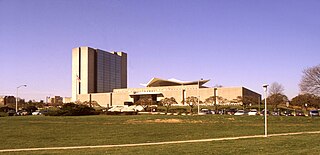
Thiamine transporter 2 (ThTr-2), also known as solute carrier family 19 member 3, is a protein that in humans is encoded by the SLC19A3 gene. SLC19A3 is a thiamine transporter.
A urea transporter is a membrane transport protein, transporting urea. Humans and other mammals have two types of urea transport proteins, UT-A and UT-B. The UT-A proteins are important for renal urea handling and are produced by alternative splicing of the SLC14A2 gene. Urea transport in the kidney is regulated by vasopressin.

Solute carrier family 22 member 2 is a protein that in humans is encoded by the SLC22A2 gene.

Equilibrative nucleoside transporter 2 (ENT2) is a protein that in humans is encoded by the SLC29A2 gene.

Solute carrier family 22 member 3 (SLC22A3) also known as the organic cation transporter 3 (OCT3) or extraneuronal monoamine transporter (EMT) is a protein that in humans is encoded by the SLC22A3 gene.

Urea transporter, erythrocyte is a protein that in humans is encoded by the SLC14A1 gene.

Sodium- and chloride-dependent taurine transporter is a protein that in humans is encoded by the SLC6A6 gene.

Aquaporin-9 is a protein that in humans is encoded by the AQP9 gene.

Solute carrier family 26 member 6 is a protein that in humans is encoded by the SLC26A6 gene. It is an anion-exchanger expressed in the apical membrane of the kidney proximal tubule, the apical membranes of the duct cells in the pancreas, and the villi of the duodenum.

Sodium-dependent multivitamin transporter is a protein that in humans is encoded by the SLC5A6 gene.

Solute carrier family 2, facilitated glucose transporter member 12 is a protein that in humans is encoded by the SLC2A12 gene.

Solute carrier organic anion transporter family member 2B1 also known as organic anion-transporting polypeptide 2B1 (OATP2B1) is a protein that in humans is encoded by the gene SLCO2B1.

Sodium-dependent phosphate transport protein 1 is a protein that in humans is encoded by the SLC17A1 gene.

Solute carrier family 13 member 3 also called sodium-dependent dicarboxylate transporter (NaDC3) is a protein that in humans is encoded by the SLC13A3 gene.

Solute carrier family 13 member 2 is a protein that is encoded in humans by the SLC13A2 gene.

Solute carrier family 22 member 9 is a protein that in humans is encoded by the SLC22A9 gene.

Solute carrier organic anion transporter family member 3A1 is a protein that in humans is encoded by the SLCO3A1 gene.

Solute carrier family 7 member 10 also known as Asc-type amino acid transporter 1 or Asc-1 is a protein that in humans is encoded by the SLC7A10 gene.

Solute carrier family 22 member 25 (SLC22A25), also known as organic anion transporter UST6, is a protein that in humans is encoded by the SLC22A25 gene.

Monocarboxylate transporter 10, also known as aromatic amino acid transporter 1 and T-type amino acid transporter 1 (TAT1) and solute carrier family 16 member 10 (SLC16A10), is a protein that in humans is encoded by the SLC16A10 gene. SLC16A10 is a member of the solute carrier family.





















